Bigfoot’s Killer-N 1102 Wireless Networking vs. the World
by Jarred Walton on August 10, 2011 10:38 AM ESTNetgear 2.4GHz Obstructed Performance
Our next test is the same router as before, only now we’ve moved the laptops to the opposite side of the house. For this test, the router is still upstairs, but the laptops are about 50 feet away (direct line) with several walls and a floor in between. As you might expect, performance is lower on every laptop in every test, though some controllers hold up better than others.
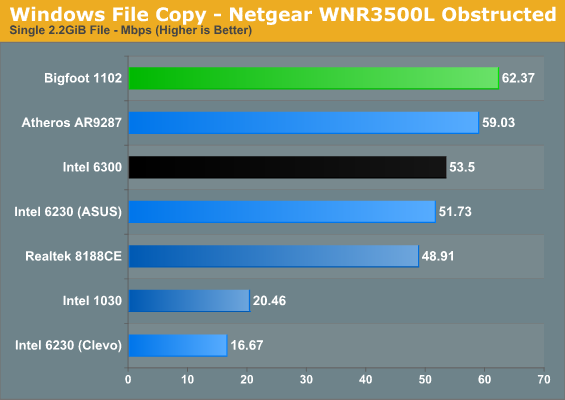
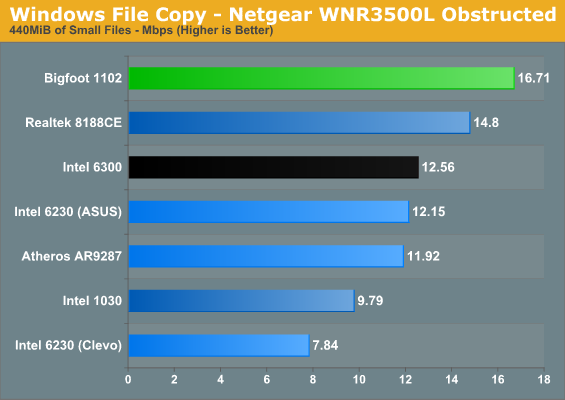
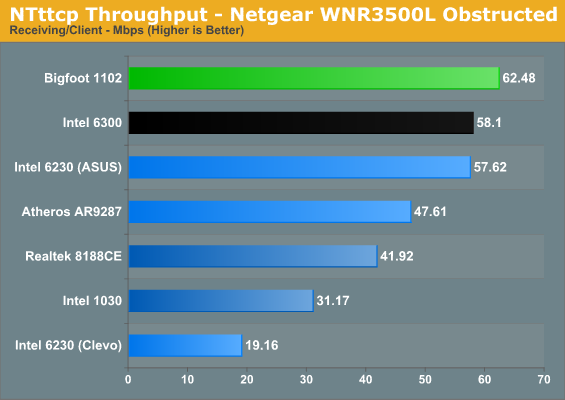
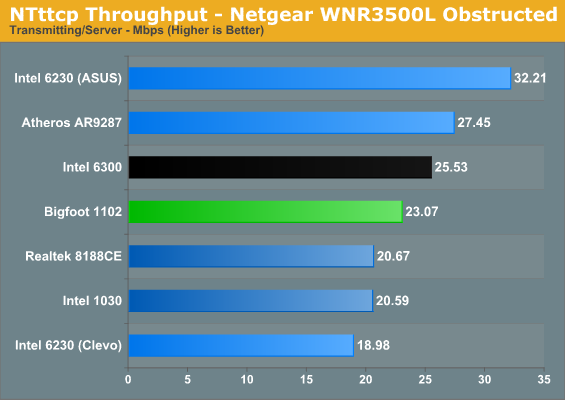
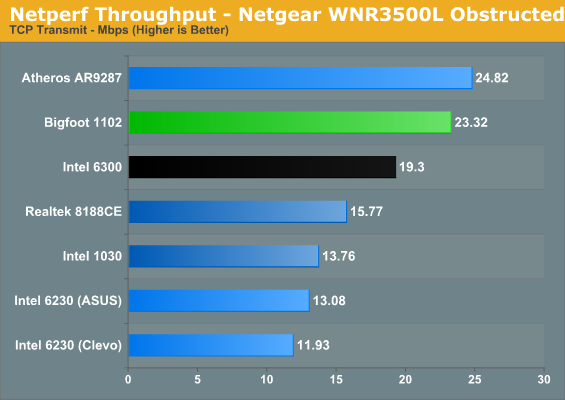
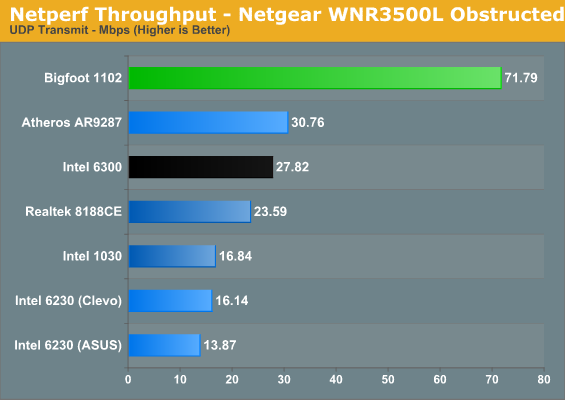
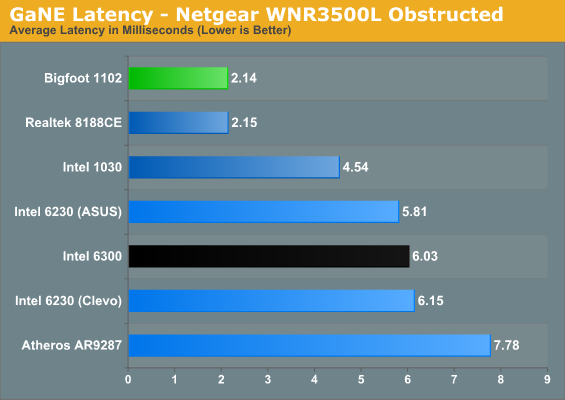
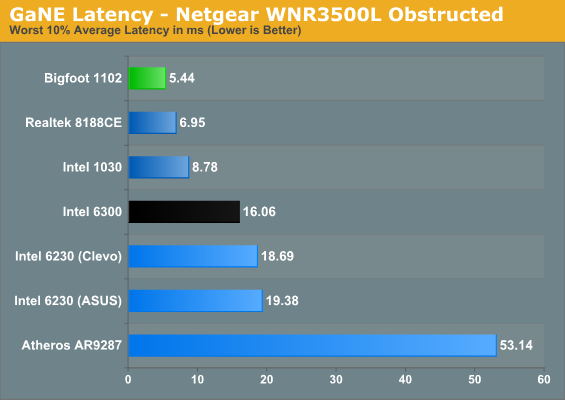
The Bigfoot 1102 leads in most of the tests, with the Realtek and Atheros generally claiming second and third. Once again, the ASUS K53E performs better than the Clevo sample unit in this test—much better in fact—despite both using the same Intel Advanced-N 6230 chipset. Also note that all of the cards do quite a bit better at receiving data than at transmitting (see the NTttcp charts), which makes sense as most laptops don’t put a ton of power into their transmit radios. It’s interesting that in our obstructed tests, the Intel 6230 (in the K53E) and 6300 along with the Atheros AR9287 all manage higher transmit rates than the BF 1102 with NTttcp, though that advantage doesn’t translate over to Netperf.
The Bigfoot 1102 still maintains a decisive lead in the latency tests, with the Realtek 8188CE nipping at its heels. Oddly enough, latency is actually lower on a couple of the cards (the K53E with Intel 6230 specifically), but that’s probably in part because the connection rate is no longer as high. Most of the laptops connected at less than 130Mbps, with a lot of variance in the speed as the cards frequently renegotiate their connections. Bigfoot also continues to dominate the copy time for lots of small files, again illustrating that their “secret low latency sauce” helps in areas other than gaming. The single stream Realtek chipset comes in second in that test, and it has the second lowest latency of the tested controllers.
The takeaway here is that even the best network cards won’t perform all that well without a clear signal. If you have a large house or office and you want to provide good coverage, setting up multiple access points would be necessary to obtain optimal performance for every room. We’ll look at how far the laptops can get from the router before experiencing connection problems later, but in most houses the Bigfoot 1102 should get a good signal.










52 Comments
View All Comments
JarredWalton - Wednesday, August 10, 2011 - link
I was estimating. I just paced it off, and walking (around corners) it's about 50 feet. In a direct line, it's more like 30 feet. I'll update the distances, though it's all very rough. (I don't have blueprints for the house, but it's about 2300 sqft with an upstairs and downstairs; corner to corner is about 50 feet I'm guessing. I'm revising the distances to be as accurate as possible, but for reference that red vehicle in the driveway is almost 20 feet long if that helps.theqat - Wednesday, August 10, 2011 - link
Any idea when we can expect the Pollux review? I'm trying to make a decision on a laptop fairly soon and I'd love to see what you guys think about it before I do so.Hrel - Wednesday, August 10, 2011 - link
I kept looking for a range test but didn't see it. Having an issue with my Clevo P150HM, had to send it back to cyberpowerpc. Got no wifi signal at all at public places like panera and starbucks. I kind need internet in those places. Huge part of the reason I even have a laptop. It has the Intel 6230 in it cause I need bluetooth.ggathagan - Wednesday, August 10, 2011 - link
Page 7? Entitled "Testing Signal Range"?Focher - Wednesday, August 10, 2011 - link
Once again, Bigfoot's product doesn't really offer anything of extra value to alternative products (personally, I think the UDP test results are wonky and it's unbelievable that a current wifi device would best wired gigabit Ethernet, let alone dominate to the extent that the test showed). You're better off getting a true 3x3:3 card, even if the current performance only matches the 1102. At worst, performance will stay the same. But there's at least a chance that the addition transmit and receive channels will enable improved performance with a firmware update. Sure, if the 1102 is the default card in a particular laptop then fine (although I'd still take the Intel 6300 over it) but I sure wouldn't pay any price premium for it unless it's an upgrade option to replaces some default low end device.neothe0ne - Wednesday, August 10, 2011 - link
yeah, Lenovo and HP are horrible companies. HP is even worse because all their consumer products force you on WiFi Link 1000 (their Bluetooth is offered in a separate chip). Most of the Probooks and Elitebooks and the Envies use Centrino 62xx cards, thankfully... but they're still whitelisted.Peroxyde - Wednesday, August 10, 2011 - link
Hi experts,Sorry for off topic question. Can you please recommend a good wireless router? I have heard of TP-Link 1043ND as being well rated. Is it really better than Linksys or DLink? Thanks in advance
jigglywiggly - Wednesday, August 10, 2011 - link
A LIL LATE FOR THIS ARTICLEI HAVE A CLEVO WITH A 6230
AAAAAAAAAAAAAAAAAAAAAAAAAAAAAAAAAAAAAAA
iamkyle - Thursday, August 11, 2011 - link
The majority of laptops can't even use this card thanks to the legalized monopolization of laptops via whitelists. That crap should be illegal.The_Laughing_Man - Thursday, August 11, 2011 - link
I think Bigfoot should sue those tier one laptop suppliers for anti-competitive practices.Whitelist should be illegal.
I have a brand new HP laptop, I can replace the WiFi card after booting and it works just fine. It is even in the same WiFi family that comes with the laptop and Windows uses the same set of drivers for both cards. But the notebook will not boot with newer dual-band card installed during start-up due to HP whit-list in their BIOS.
On top of that HP encrypts their BIOS such that is is very difficult to hack their BIOS to allow valid WiFi cards, not to mention other things.
HP doesn't even offer an upgrade to a dual-band WiFi card for this very expensive high-end notebook the DV7T, even if I was willing to pay them for it.
And Dell, Asus, Acer, and Sony all do the same thing.
They all need to be sued. And until they remove their whitelists, Bigfoot will be forced to have a very small market to sell their mini-pcie killer-n card to.